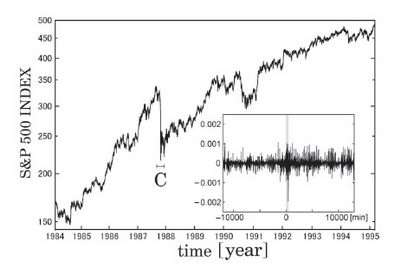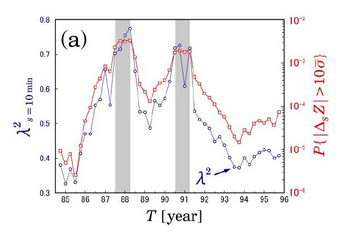February 24, 2006 feature
Physicists Predict Stock Market Crashes

On Monday, October 19, 1987 – infamously known as “black Monday” – the Dow fell 508 points, or 22.9%, marking the largest crash in history. Using an analytical approach similar to the one applied to explore heart rate, physicists have discovered some unusual events preceding the crash. These findings may help economists in risk analysis and in predicting inevitable future crashes.
Although stock prices fluctuate, the variations across the overall market are relatively small, as well as similarly random (or “Gaussian”) on a large time scale. Nobody knows what causes the giant drops that result in market crashes, except that crashes involve a variety of factors.

While analyzing stock-price fluctuations based on critical dynamics and phase transitions, physicists from the University of Tokyo (Kiyono et al.) have observed some surprising behavior preceding market crashes. During the year before black Monday, the team found that the probability of large price fluctuations increased unexpectedly (“non-Gaussian” behavior), as if approaching a critical point signifying a major change. At the critical point – or day of the crash – an abrupt phase transition did indeed occur as the probability model changed from being scale dependent to scale invariant. Scale invariance, which in this case meant that the prices no longer depended on the time scale, is characteristic behavior observed at a critical point.
“Because the probability of the occurrence of extremely large fluctuations shows a sharp increase before black Monday…our observations suggest that, through the internal dynamics, the system gradually approaches a critical point where inherent, multi-scale fluctuations are likely to result in a crash,” said the scientists in a study published in a recent Physical Review Letters.
This “critical” model builds on the idea that the volatility, or variation, of price changes can quantitatively measure how much the market may fluctuate. In fact, volatility – not actual price – is the key input in Black and Scholes’ “option pricing” model on price variation over time, developed in 1973 and highly influential in financial markets.
However, volatility alone could not explain the occurrence of large price fluctuations found by Kiyono et al. The team also studied price changes on a short (10-minute) time scale, and discovered a probability of large fluctuations on this scale, as well. This similarity of fluctuations on different time scales resembles the behavior of earthquakes and heartbeats, which are also scale invariant. The physicists think that the small-scale stock price fluctuations may have caused highly clustered behavior of individual traders, which then grew rapidly through internal interactions in the stock market.
“If the same characteristics can be observed in other stock indices, our approach may be applicable to quantitative risk evaluation,” the scientists reported.
Does an increasing probability of price fluctuations necessarily mean a crash will occur? Not at all, since even the most statistically promising analysis cannot account for external factors. For example, the team observed extreme price fluctuations in log returns before 1990. However, because the Iraqi attack on Kuwait in August 1990 and the Gulf War in 1991 led to declining stock prices and action, the internal dynamics of the market underwent a radical change and a phase transition and critical point did not occur.
Citation: Kiyono, Ken, Struzik, Zbigniew R., and Yamamoto, Yoshiharu. Criticality and Phase Transition in Stock-Price Fluctuations. Physical Review Letters. 96, 068701 (2006)
By Lisa Zyga, Copyright 2006 PhysOrg.com
















